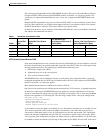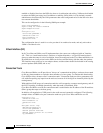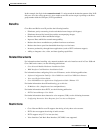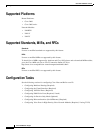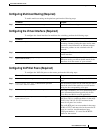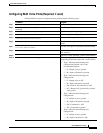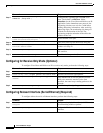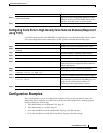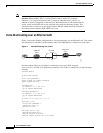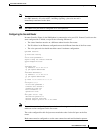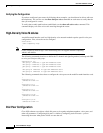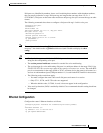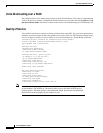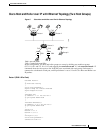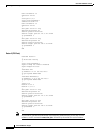
Cisco Hoot and Holler over IP
Configuration Examples
17
Cisco IOS Release 12.1(5)T
Configuring Voice Ports in High-Density Voice Network Modules (Required, if
using T1/E1)
A multiflex trunk interface card (NM-HDV) in a high-density voice network module requires special
voice-port configuration when connecting for T1/E1 operation. Perform the following steps:
Configuration Examples
This section provides a series of configuration examples to help you become familiar with voice
multicasting. These examples also show how to ensure that each configuration is working properly
before proceeding to the next step.
• Voice Multicasting over an Ethernet LAN, page 18
• Voice Multicasting over a WAN, page 22
• Cisco Hoot and Holler over IP with Ethernet Topology (Two Hoot Groups)
• Cisco Hoot and Holler over IP with Frame-Relay Topology (One Hoot Group)
Step 3
Router(config-if)# ip pim { sparse mode | dense-mode |
sparse-dense-mode }
Specifies Protocol Independent Multicast (PIM).
Whatever mode you choose should match all the
interfaces in all the routers of your network.
Step 4
Router(config-if)# no shutdown
Enables the interface.
Command Purpose
Command Purpose
Step 1
Router(config)# voice class permanent tag1
Defines voice class for transmit-receive mode.
Step 2
Router(config-class)# signal timing oos timeout
disabled
Disables signaling loss detection.
Step 3
Router(config-class)# signal keepalive number
Specifies keepalive signaling packet interval.
Step 4
Router(config-class)# exit
Returns to global configuration mode.
Step 5
Router(config)# voice-card number
Selects the card to configure.
Step 6
Router(config-voicecard)# codec complexity high
Codec complexity must be high. Voice
multicasting does not support medium complexity,
which is the default.
Step 7
Router(config)# controller { t1 | e1 } slot/port
Selects the T1 or E1 controller to configure.
Step 8
Router(config-controller)# ds0-group ds0-group-number
timeslots timeslot-list type type
Maps a group of time slots to a DS0 group.
Step 9
Router(config)# voice-port slot/port:ds0-group-number
Configures a DS0 group that was created in Step 4.
Step 10
Router(config-voice-port)# connection trunk
multicast-address
Ties the connection trunk to a multicast address.
This command is repeated for each DS0 group. All
groups use the same multicast address, if
connecting to the same multicast session.
Step 11
Router(config-voice-port)# voice-class permanent tag2
Uses voice class tag2 for the receive-only port.



